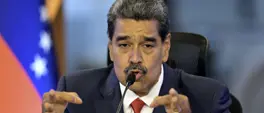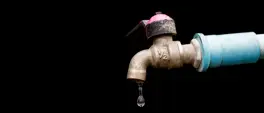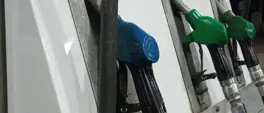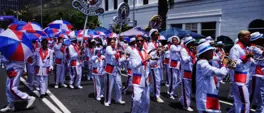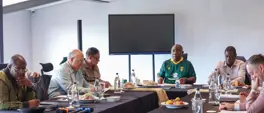JUDITH FEBRUARY | In a world on fire, South Africa fumbles for answers
Judith February
15 August 2025 | 11:25"How different the world might be if, while grappling with systemic injustice if our ways of seeing were more multi-dimensional. There are lessons for our country in this too. "
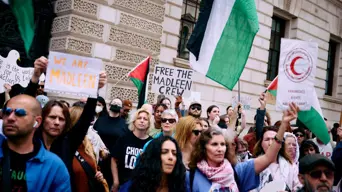
People take part in a protest outside the Foreign Office in central London, on June 9, 2025, to demand that the UK government protects the crew of the "Gaza Freedom Flotilla" boat Madleen.
We long for an easier world.
War in Ukraine continues, the situation in Gaza has escalated into an assault on all humanity, Trump’s assault on democracy threatens the world and already Europe is in a race to arm as the post-war consensus lies virtually in threads.
No-one is immune from this. Here at home we continue to battle poverty, inequality and unemployment (the so-called ‘triple ills’) as well as ongoing corruption where the culture of impunity is now endemic. Our President flounders in the midst of crises not least of which is the economy. Hard choices need to be made yet we bumble along in typically South African fashion.
There are also those he harbours within his cabinet who are corrupt. We know who they are. And they include convicted felons and xenophobes like Gayton McKenzie, a dangerous embarrassment, comfortable fomenting hate but who seems to be made of teflon. The deputy President himself seems to be the source of much unexplained wealth and involved in alleged nefarious activities.
As a way to deal with messy politics, having squandered much of the goodwill with which his Presidency started, a National Dialogue was decided upon.
Predictably it has been mired in controversy- even before the DA's withdrawal and later the withdrawal of a number of Foundations who had been committed to participate. Almost from the start it felt like something President Ramaphosa decided on while looking for a ‘stocking filler’ as he addressed the nation.
And then there were the 'Eminent Persons Group' which felt, in part, like a star-studded cast lining up for an Awards ceremony. (We love Siya Kolisi but, really? Ditto, the reigning Miss South Africa etc etc).
Dialogue is important but, what South Africa urgently needs is action about the things that matter, most notably, the economy which is suffering the slings and arrows of US President Trump’s tariffs, amongst many other ills.
Perhaps artist William Kentridge said it best when, during his Royal Academy, London exhibition in 2023 he was asked about the current state of our country, he replied, “Struggling to rescue itself from the degradations of the last 10 years, in terms of its infrastructure, and also understanding that 300 years of white settler colonialism cannot be undone so quickly. It’s a mess. That’s the quick answer.”
A quick but complex answer. Aside from our challenges we need to ask ourselves some serious questions about the language we use in our interactions with one another and how we can find ways to speak with greater care about the things which ail us.
Sometimes art provides us with more opportunity for dialogue and critical thinking so necessary if we want to have a thoughtful gaze on our world, wracked by inequality, racism and division. A world in which there is so much to lament.
Recently Amy Sherald opened her exhibition, ‘American Sublime’ at the Whitney museum in New York.
"We stand here tonight, in defiance of erasure. We stand in presence of beauty, of history, of ourselves, and we will not be moved," she said.
Sherald’s work, is simply aesthetically beautiful. But, like all good art, it provides pause for thought. Her work is a clear, if subtle, call to think about blackness differently. Best known for her official portrait of Michelle Obama, Sherald has risen far beyond the trite.
She describes her thinking, depicting black people in her usual grayscale and her portrayal of the quotidian: “I’m not trying to take race out of the work, I was just trying to figure out a way to not make it the most salient thing about it.
“My work doesn’t commit black life to grief. There’s an assumption of a whole black life being inextricably tied to struggle. I think it becomes all-consuming and really can codify our existence and our whole experience.
“I wanted to emulate the quiet presence I saw in those pictures, which were some of the first images where blacks were able to present themselves the way they wanted to be seen.
“Painting images that look like that was really important, not just for ourselves, but for the rest of the world to see us that way, too,” Sherald explained.
Sherald’s work cuts helpfully through the “them and us” paradigm (while ironically employing the very paradigm), presenting black life as ordinary and in some of that ordinariness, reclaiming dignity, humanity and place.
(For a deeper discussion of the portrayal of the black quotidian, see here.)
Zadie Smith reminds us so brilliantly in her essay after the 2016 US elections of the necessary lens of perspective.
‘‘We forget that our particular moment, with all its tribulations and triumphs, is not neatly islanded in the river of time but swept afloat by massive cultural currents that have raged long before it and will rage long after. I have long believed that critical thinking without hope is cynicism, but hope without critical thinking is naïveté.”
How different the world might be if, while grappling with systemic injustice if our ways of seeing were more multi-dimensional. There are lessons for our country in this too.
Get the whole picture 💡
Take a look at the topic timeline for all related articles.



